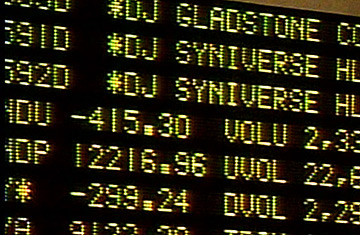
The big board at the New York Stock Exchange at the close of trading, February 27, 2007.
China's selloff came as stocks there moved off record highs amid fears that Beijing might raise interest rates to slow economic growth. It came at a time when the U.S. markets were ripe for a correction: analysts noted that the Dow has not dropped by as much as 2% in more than 120 trading days.
For the past few months,Ben Bernanke, chairman of the Federal Reserve Bank, has helped drive equities higher with his upbeat views on the economy. In his semiannual congressional testimony last week, the Fed chairman laid out a rosy scenario, predicting that U.S. growth would continue "at a moderate pace this year and next, with growth strengthening somewhat as the drag from housing diminishes."
But Alan Greenspan, Bernanke's august predecessor, this week painted a gloomier picture, predicting a slowdown late in 2007. Speaking via satellite link to a business conference in Hong Kong, he declared, "When you get this far away from [the last] recession, invariably forces build up for the next recession, and indeed we are beginning to see that sign." He added: "For example in the U.S., profit margins ... have begun to stabilize, which is an early sign we are in the later stages of a cycle."
Whipsawed by the contradictory views, investors who had bought stocks on Bernanke's optimistic remarks sold them on Greenspan's dour pronouncements, taking Wall Street into its biggest one-day drop in three years, capping off five consecutive day of losses.
The economy may indeed be overdue for a recession. The last U.S. downturn ended in November 2001. That means the U.S. economy has now been expanding for more than five years — 63 months, to be exact. Since World War II, the average time between recessions has been just 57 months. On the other hand, the last period of sustained economic growth lasted 10 years, from 1991 to 2001. And the one before that lasted 92 months, from 1982 to 1990.
For many folks on Main Street, however, the economy seems to be looking just fine. U.S. consumer confidence rose this month to its highest point in more than five years, propelled by rising wages and more jobs. The Conference Board's index increased to 112.5 from 110.2 last month, and the percentage of those saying jobs are hard to get fell to its lowest level since August 2001. That news seems to bolster Bernanke's upbeat view, and his argument that consumers are the ``mainstay'' of an economy heavily dependent on their spending.
But for those who view things from Greenspan's perspective, there are worrisome indicators. Orders for durable goods — covering everything from jet engines to computers, as well as washing machines and other household appliances — fell more than forecast last month, the Commerce Department announced, a sign of ongoing weakness in manufacturing. The 7.8% decline was the biggest since October. Another important indicator of business spending, orders for nondefense capital goods not including aircraft, fell 6%, the third drop in four months.
Even though a new report from the National Association of Realtors showed that sales of previously owned homes rose 3% in January, the median price of those homes fell to $210,600, down 3% from the same period last year. Inventories of unsold homes also remain high.
Just as important is the current slump for so-called "sub-prime" lenders — who service borrowers with damaged credit ratings, typically on the lower end of the income scale. The shares of companies that specialize in such loans has fallen as default rates have risen.
The precise strength of the U.S. economy appears to be in the eye of the beholder. But on Tuesday Wall Street made clear that it sees trouble ahead — at least for one day.
